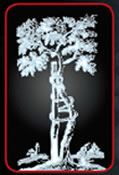The foot and ankle are frequently injured during sporting events. In many cases, the diagnosis is apparent based on the history, physical examination, and plain radiographs. In other cases, the presentation may be confusing or nonspecific. In these cases, special imaging modalities may be useful to determine or confirm the diagnosis. This article will show examples of sports injuries for which special-imaging modalities may be particularly useful in determining the correct diagnosis, such as ligament and tendon injuries, normal variants, tarsal tunnel syndrome, occult fractures, and stress fractures.
The foot and ankle are frequently injured during sporting events and may produce considerable disability in many athletes. Injuries of the foot and ankle may be acute or chronic problems. Cass and Morrey1 reported that acute foot and ankle injuries accounted for 10% of emergency room visits. Garrick and Requa2 reported that foot and ankle injuries represented over 25% of the 16,00 athletic injuries in their series. In many cases, an accurate diagnosis can be made using the history, physical examination, and plain radiographs; special-imaging modalities are not required to make or confirm the diagnosis. In many other cases, the diagnosis may not be as apparent. In these cases, special imaging may be useful in determining the correct diagnosis. This report will show some examples of how special-imaging modalities can be used to diagnose various clinical entities of the foot and ankle. The examples will be considered according to the anatomic structure that is effected (ie, ligaments, tendons, etc).
Ligaments
Ligamentous structures are important for maintaining stability in the hindfoot and are frequently injured in sporting events. The anterior and posterior tibial and fibular ligaments (ATiFL and PTiFL) help to maintain the stability of the distal tibial and fibular syndesmosis and are transversely oriented at a level just above the tibiotalar joint (Fig 1).3 At this level, the fibula has an oval shape with a convex posterior surface (Fig 1). The convex shape of the fibula distinguishes the PTiFL from the similarly oriented posterior talofibular ligament that is located at a lower level (Fig 2A).
There are three lateral collateral ligaments: the anterior and posterior talofibular ligaments (ATFL and PTFL) and the calcaneofibular ligament. The ATFL and PTFL are best seen in axial magnetic resonance (MR) images at the level of the posterior concavity of the fibula (Fig 2A). The ATFL is the most frequently injured ligament and the calcaneofibular ligament is the second most frequently injured lateral ligament (Fig 2B).
Some patients develop a focal soft-tissue massand focal pain in the interval between the anterior tibia and fibula after a severe ankle sprain. 4 The term "meniscoid syndrome" has been coined to describe the hyalinized synovial tissue that is frequently found in the location of the mass. MR imaging of meniscoid syndrome shows low signal (dark) tissue in the interval between the anterior tibia and fibula (Fig 3).4
The PTFL attaches to the posterior process of the talus and may be avulsed during an ankle inversion injury. The PTFL is frequently seen using MR images in the coronal plane but can be misinterpreted as an osteochondral body using sagittal images (Fig 4). If the PTFL is followed on contiguous images it will not be mistaken for an osteochondral body. The os trigonum is an accessory ossification center of the posterior process of the talus and can be distinguished from a posterior process avulsion fracture by the absence of marrow or soft-tissue edema. An os trigonum has an undulating synostosis compared with a straight line fracture (Fig 5).
The medial collateral or deltoid ligament is composed of superficial (tibiocalcaneal) and deep (tibiotalar) fibers (Fig 6).5-9 The deltoid ligament complex is composed of a group of fibers sharing the origin from the medial mallelous and arranged into superficial and deep layers.8, 10 The superficial fibers arise from the anterior colliculus: the tibiocalcaneal, tibiospring, and tibionavicular ligaments.8, 10 The deep layer is composed of the anterior and posterior tibiotalar ligaments.8, 10 The various components of the deltoid ligament complex (except the anterior tibiotalar ligament) can be consistently seen using multiplanar reconstructions of three-dimensional transform gradient-echo MR images.8 In a series of 26 patients with medial ligamentous injuries, Klein et al8 found tears of the tibionavicular ligament in 69%, the tibiocalcaneal ligament in 65%, tibiospring ligament in 35%, and the posterior tibiotalar ligament in 15%. The posterior tibiotalar and tibiocalcaneal ligaments are most easily seen using conventional coronal plane imaging (Fig 6). When these structures are torn, the more anteriorly located ligaments (tibionavicular and anterior tibiotalar) were invariably torn. The deltoid ligaments are torn during an ankle eversion injury and are less commonly torn than fibers of the lateral collateral ligaments.
. . . Continue to article and footnotes (PDF).
Dr. Douglas Smith is an Internationally Recognized Orthopedic MRI Expert and Teleradiologist with training in both Orthopedics at Mayo Clinic and Radiology at Mallinkrodt Institute. Dr. Smith has been a pioneer in MRI Technology since 1984 and has written over 35 peer-reviewed articles and has lectured around the world.
See Dr. Douglas Smith's Profile on Experts.com.
©Copyright - All Rights Reserved
DO NOT REPRODUCE WITHOUT WRITTEN PERMISSION BY AUTHOR.









